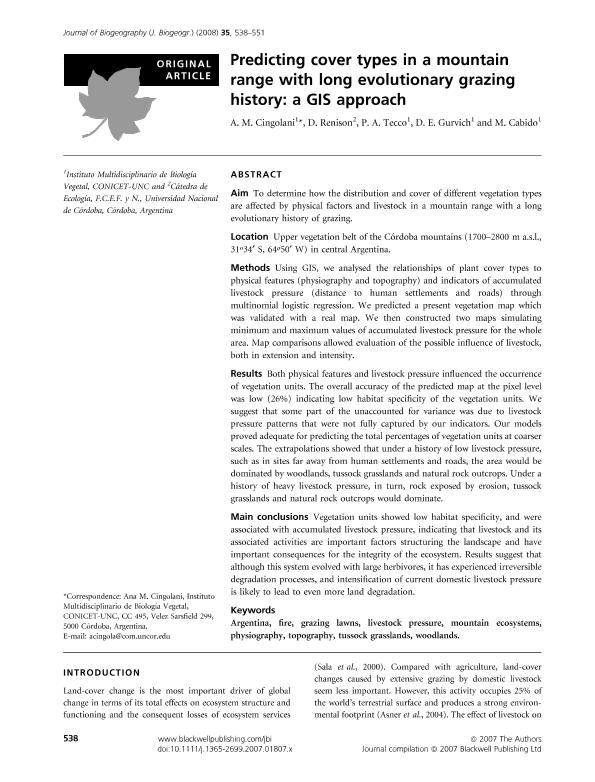Mostrar el registro sencillo del ítem
dc.contributor.author
Cingolani, Ana María

dc.contributor.author
Renison, Daniel

dc.contributor.author
Tecco, Paula Andrea

dc.contributor.author
Gurvich, Diego Ezequiel

dc.contributor.author
Cabido, Marcelo Ruben

dc.date.available
2017-11-23T17:02:39Z
dc.date.issued
2008-03
dc.identifier.citation
Cingolani, Ana María; Renison, Daniel; Tecco, Paula Andrea; Gurvich, Diego Ezequiel; Cabido, Marcelo Ruben; Predicting cover types in a mountain range with long evolutionary history of grazing: a GIS approach; Wiley Blackwell Publishing, Inc; Journal of Biogeography; 35; 3; 3-2008; 538-551
dc.identifier.issn
0305-0270
dc.identifier.uri
http://hdl.handle.net/11336/28878
dc.description.abstract
Aim To determine how the distribution and cover of different vegetation types are affected by physical factors and livestock in a mountain range with a long evolutionary history of grazing. Location Upper vegetation belt of the Córdoba mountains (1700–2800 m a.s.l., 31º34' S, 64º50' W) in central Argentina. Methods Using GIS, we analysed the relationships of plant cover types to physical features (physiography and topography) and indicators of accumulated livestock pressure (distance to human settlements and roads) through multinomial logistic regression. We predicted a present vegetation map which was validated with a real map. We then constructed two maps simulating minimum and maximum values of accumulated livestock pressure for the whole area. Map comparisons allowed evaluation of the possible influence of livestock,both in extension and intensity. Results Both physical features and livestock pressure influenced the occurrence of vegetation units. The overall accuracy of the predicted map at the pixel level was low (26%) indicating low habitat specificity of the vegetation units. We suggest that some part of the unaccounted for variance was due to livestock pressure patterns that were not fully captured by our indicators. Our models proved adequate for predicting the total percentages of vegetation units at coarser scales. The extrapolations showed that under a history of low livestock pressure, such as in sites far away from human settlements and roads, the area would be dominated by woodlands, tussock grasslands and natural rock outcrops. Under a history of heavy livestock pressure, in turn, rock exposed by erosion, tussock grasslands and natural rock outcrops would dominate. Main conclusions Vegetation units showed low habitat specificity, and were associated with accumulated livestock pressure, indicating that livestock and its associated activities are important factors structuring the landscape and have important consequences for the integrity of the ecosystem. Results suggest that although this system evolved with large herbivores, it has experienced irreversible degradation processes, and intensification of current domestic livestock pressure is likely to lead to even more land degradation.
dc.format
application/pdf
dc.language.iso
eng
dc.publisher
Wiley Blackwell Publishing, Inc

dc.rights
info:eu-repo/semantics/openAccess
dc.rights.uri
https://creativecommons.org/licenses/by-nc-sa/2.5/ar/
dc.subject
Argentina
dc.subject
Fire
dc.subject
Grazing Lawns
dc.subject
Livestock Pressure
dc.subject
Mountain Ecosystems
dc.subject
Physiography
dc.subject
Topography
dc.subject
Tussock Grasslands
dc.subject
Woodlands
dc.subject.classification
Otras Ciencias Biológicas

dc.subject.classification
Ciencias Biológicas

dc.subject.classification
CIENCIAS NATURALES Y EXACTAS

dc.title
Predicting cover types in a mountain range with long evolutionary history of grazing: a GIS approach
dc.type
info:eu-repo/semantics/article
dc.type
info:ar-repo/semantics/artículo
dc.type
info:eu-repo/semantics/publishedVersion
dc.date.updated
2017-10-19T20:37:00Z
dc.identifier.eissn
1365-2699
dc.journal.volume
35
dc.journal.number
3
dc.journal.pagination
538-551
dc.journal.pais
Estados Unidos

dc.journal.ciudad
Hoboken
dc.description.fil
Fil: Cingolani, Ana María. Consejo Nacional de Investigaciones Científicas y Técnicas. Centro Científico Tecnológico Conicet - Córdoba. Instituto Multidisciplinario de Biología Vegetal. Universidad Nacional de Córdoba. Facultad de Ciencias Exactas Físicas y Naturales. Instituto Multidisciplinario de Biología Vegetal; Argentina
dc.description.fil
Fil: Renison, Daniel. Consejo Nacional de Investigaciones Científicas y Técnicas. Centro Científico Tecnológico Conicet - Córdoba. Instituto de Investigaciones Biológicas y Tecnológicas. Universidad Nacional de Córdoba. Facultad de Ciencias Exactas, Físicas y Naturales. Instituto de Investigaciones Biológicas y Tecnológicas; Argentina
dc.description.fil
Fil: Tecco, Paula Andrea. Consejo Nacional de Investigaciones Científicas y Técnicas. Centro Científico Tecnológico Conicet - Córdoba. Instituto Multidisciplinario de Biología Vegetal. Universidad Nacional de Córdoba. Facultad de Ciencias Exactas Físicas y Naturales. Instituto Multidisciplinario de Biología Vegetal; Argentina
dc.description.fil
Fil: Gurvich, Diego Ezequiel. Consejo Nacional de Investigaciones Científicas y Técnicas. Centro Científico Tecnológico Conicet - Córdoba. Instituto Multidisciplinario de Biología Vegetal. Universidad Nacional de Córdoba. Facultad de Ciencias Exactas Físicas y Naturales. Instituto Multidisciplinario de Biología Vegetal; Argentina
dc.description.fil
Fil: Cabido, Marcelo Ruben. Consejo Nacional de Investigaciones Científicas y Técnicas. Centro Científico Tecnológico Conicet - Córdoba. Instituto Multidisciplinario de Biología Vegetal. Universidad Nacional de Córdoba. Facultad de Ciencias Exactas Físicas y Naturales. Instituto Multidisciplinario de Biología Vegetal; Argentina
dc.journal.title
Journal of Biogeography

dc.relation.alternativeid
info:eu-repo/semantics/altIdentifier/url/http://onlinelibrary.wiley.com/doi/10.1111/j.1365-2699.2007.01807.x/full
dc.relation.alternativeid
info:eu-repo/semantics/altIdentifier/doi/http://dx.doi.org/10.1111/j.1365-2699.2007.01807.x
Archivos asociados
